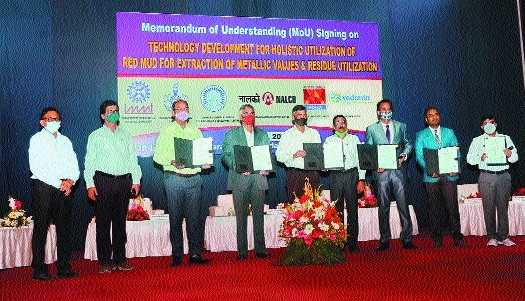R&D institutions now work together to extract REE from aluminium waste
| Date :05-Apr-2021 |

Prof. Suddhasatwa Basu, Manasa Mishra, Rakesh Mohan, Ardhendu Mohapatra, Dr Upendra Kumar Singh and other heads of different institutes during the signing of MoU.
By Kaushik Bhattacharya :
City’s JNARDDC signed MoU with other institutes under the initiative of NITI Aayog to do research work.
India can locally extract Scandium from red mud for space and defence technologies
To reduce import dependence on China for Rare Earth Elements (REE), Government of India took a bold technological step to extract REE from aluminium waste (Red Mud) under Atmanirbhar Bharat Mission. Under the initiative of Government of India’s NITI Aayog, city-based institute Jawaharlal Nehru Aluminium Research Development Design Centre (JNARDDC) signed a Memorandum of Understanding (MoU) with CSIR-Institute of Minerals and Materials Technology (CSIR-IMMT), Bhubaneswar; CSIR-National Metallurgical Laboratory (CSIR-NML), Jamshedpur; National Aluminium Company Ltd. (NALCO), Hindalco Industries Ltd. and Vedanta Ltd., recently. Red Mud is produced in the process of alumina extraction from bauxite. Bayer’s process is the principal industrial means of processing bauxite to produce alumina (aluminium oxide).
Statistically, production of 1 tonne alumina generates 1-1.5 tonnes of red mud depending upon the mineralogical composition of the bauxite and extraction efficiencies. “India is the fourth-largest producer of aluminium in the world with a share of around 5.3 per cent of the global aluminium output, hence, the development of red mud’s effective handling, storage, usage and management is necessary for the welfare of the global community,” Dr Upendra Singh, Principal Scientist, JNARDDC told The Hitavada. REEs are strategic elements crucial for sustainable energy systems. NITI Aayog has identified red mud to be one of rich secondary source of REEs and has recommended adopting a holistic approach for the utilisation of red mud, Dr Singh informed. China today controls nearly 90 per cent of global rare earth production, posing a vulnerability to manufacturing industries. Amid the stand-off situation with China, Government of India had decided to reduce the dependency over China for REE by extracting REEs from locally available sources.
“Scandium is one of the strategic element in the group of REEs which is utilise in space and defence technologies at large number. India produce 10 million tonnes of red mud per annum in which we can extract about 4,000 tonnes of Scandium per annum,” said Dr Anupam Agnihotri, Director, JNARDDC. Dr Agnihotri said, “India has a stock of 2 Billion tonnes of red mud from which we can extract huge amount of REEs to cater our own demand which will also reduce the dependency of these metals from China. “Red mud is highly hazardous for nature and human health. JNARDDC is the only institution in the country that invented a technology to extract REE from red mud and also to reuse red mud for other commercial activities. Today, we are just reusing 1% of red mud and remaining 99% is just dumped as a waste.”
The MoU outlines financial and technical roles of the participating industries and also to do more joint research and development. Apart from extraction of REEs, attempts will also be made to extract iron, alumina and titanium present in red mud. Prof. Suddhasatwa Basu, Director, CSIR-IMMT; Dr Ashok Kumar Sahu, Head, Strategy Planning and Business Development, CSIR-IMMT; Manasa Mishra, Director (P&T), NALCO; Subrat Kar, Group GM (Research and Development), NALCO; Rakesh Mohan, Director (Technical), VEDANTA; Rajan Babu, Head, Bauxite and Red Mud Management, Lanjigarh, VEDANTA; Ardhendu Mohapatra, Joint President, Corporate Affairs, Hindalco Industries Ltd.; Soubhagya Kumar Tripathy, GM, Corporate Sustainability, Hindalco Industries Ltd; Dr Upendra Kumar Singh, Principal Scientist, JNARDDC; and Sudhakara Rao K, RDPD, CSIR-NML also were present during the MoU signing ceremony that took place in Bhubaneswar.